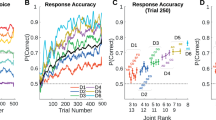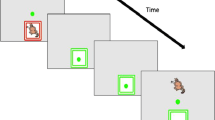Abstract
Carmesin and Schwegler (1994) have determined theoretically that a linear hierarchical stimulus structure can be encoded by a parallel network of minimal complexity. The experiments reported here compare the efficiency with which humans and pigeons process sets of stimulus pairs embodying different inequality structures. Groups of subjects of each species were taught to discriminate all 10 pairwise combinations of 5 stimuli with an operant conditioning method. For one group, the reward/punishment allocations within the pairs agreed with a linear hierarchy. For a second and third group, the reinforcement allocations of one or three, respectively, of the stimulus pairs deviated from such ordering. The time it took the subjects to learn the tasks as well as the final choice latencies and/or error rates increased with the number of deviating inequalities. The results agree with the assumption that both humans and pigeons encode stimulus inequality structures with parallel processing neural networks rather than with a sequentially processing algorithm.
Similar content being viewed by others
References
Archer J (1992) Ethology and human development. Harvester Wheatsheaf, New York
Carmesin HO, Schwegler H (1994) Parallel versus sequential processing of relational stimulus structures. Biol Cybern 71:523–529
Couvillon PA, Bitterman ME (1992) A conventional conditioning analysis of “transitive inference” in pigeons. J Exp Psychol [Anim Behav Proc] 18:308–310
Fersen L von, Delius JD (1992) Schlußfolgerndes Denken bei Tauben. Spektr Wiss July: 18–22
Fersen L von, Wynne CDL, Delius JD, Staddon JER (1991) Transitive inference formation in pigeons. J Exp Psychol [Anim Behav Proc] 17:334–341
Gellermann LW (1933) Chance orders of alternating stimuli in visual discrimination experiments. J Genet Psychol 42:206–208
Henley N, Horsfall R, De Soto C (1969) Goodness of figure and social structure. Psychol Rev 76:194–204
Herrnstein RJ (1990) Levels of stimulus control: a functional approach. Cognition 37:133–166
Luce DR (1959) Individual choice behavior. Wiley, New York
Medin DL, Smith EE (1984) Concepts and concept formation. Annu Rev Psychol 35:113–138
Potts GR (1972) Information strategies used in the encoding of linear orderings. J Verbal Learn Behav 103:431–439
Rescorla RA, Wagner AR (1972) A theory of Pavlovian conditioning: variations in the effectiveness of reinforcement and nonreinforcement. In: Black AH, Prokasy WF (eds) Classical conditioning II: current research and theory. Appleton-Century-Crofts, New York, pp 64–99
Riley CA (1976) The representation of comparative relations and the transitive inference task. J Exp Child Psychol 22:1–22
Siemann M (1993a) Trnsitive inferences, experimentelle Untersuchung einer kognitiven Leistung. Dissertation, University of Konstanz
Siemann M (1993b) Transitive inferences in pigeons and humans. In: Elsner N, Heisenberg M (eds) Gene, brain, behavior. Thieme, Stuttgart, p 857
Siemann M, Delius JD (1993) Implicit deductive responding in humans. Naturwissenschaft 80:364–366
Trabasso T, Riley CA (1975) The construction and use of representation involving linear order. In: Solso RL (ed) Information processing and cognition. The Loyola Symposium. Erlbaum, New York, pp 381–410
Terrace HS (1987) Chunking by a pigeon in a serial learning task. Nature 325:149–151
Werner U, Köppl U, Delius JD (1992) Transitive Inferenz bei nichtverbaler Aufgabenstellung. Z Exp Angew Psychol 19:662–683
Wickelgren WA (1979) Cognitive psychology. Prentice Hall, Englewood Cliffs
Wynne CDL, Fersen L von, Staddon JER (1992) Pigeons' transitive inferences are the outcome of elementary conditioning principles: a response. J Exp Psychol [Anim Behav Proc] 18:313–315
Xia L, Wynne CDL, Münchow-Pohl F von, Delius JD (1991) Psychobasic: a Basic dialect for the control of psychological experiments with the Commodore-64 and Dela interfacing. Behav Res Method Instr Comp 23:72–76
Author information
Authors and Affiliations
Rights and permissions
About this article
Cite this article
Siemann, M., Delius, J.D. Processing of hierarchic stimulus structures has advantages in humans and animals. Biol. Cybern. 71, 531–536 (1994). https://doi.org/10.1007/BF00198471
Received:
Accepted:
Issue Date:
DOI: https://doi.org/10.1007/BF00198471




